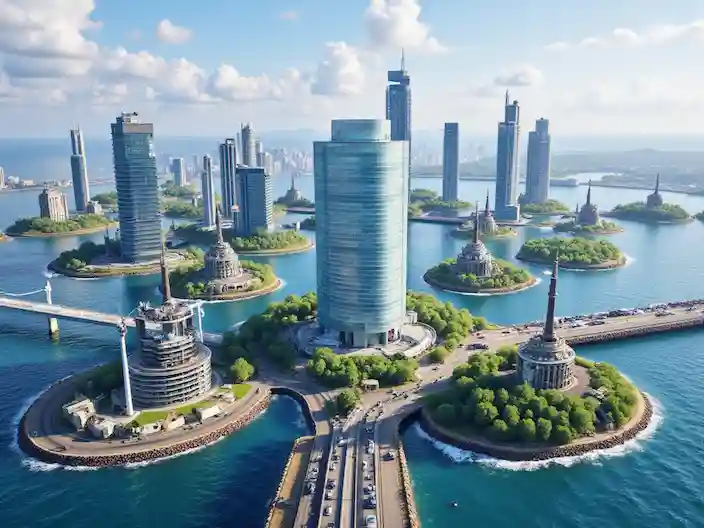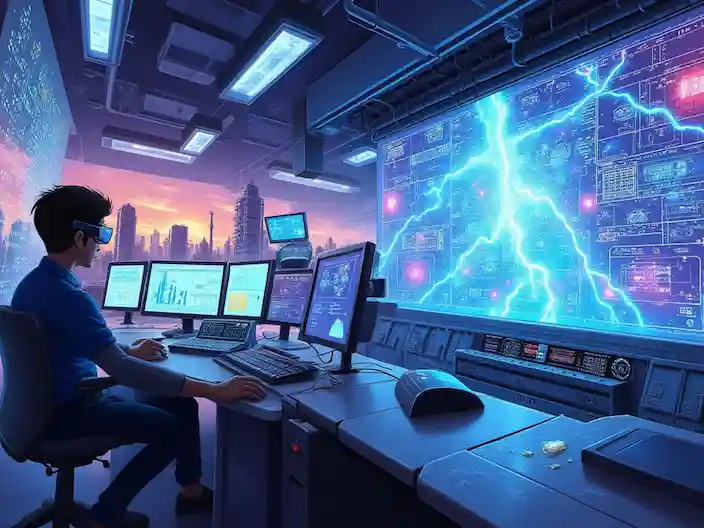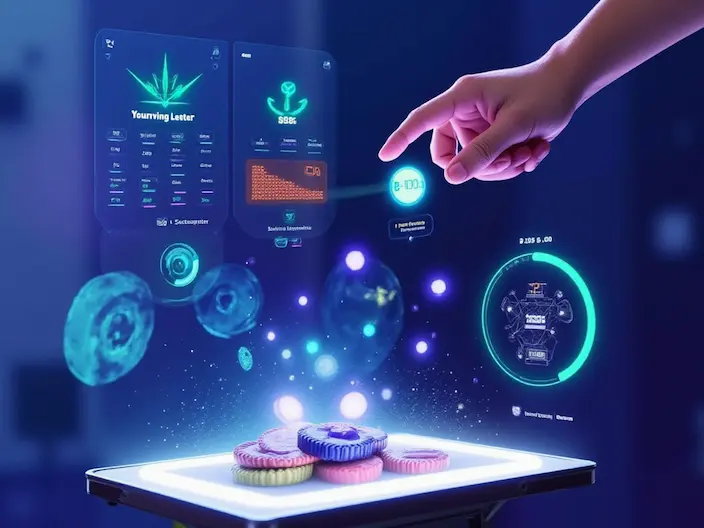Introduction
The emergence of the Metaverse as the foundation of the future digital world promises a major transformation in how humans interact with technology. Beyond being a mere virtual environment, the Metaverse serves as a comprehensive platform for creating self-organizing virtual worlds that encompass social, economic, and even industrial interactions. These spaces, built on Virtual Reality (VR), Augmented Reality (AR), and Cloud Computing, demand vast computational power, data storage, and communication infrastructure.
Although the Metaverse offers a world without physical limitations, the hidden energy consumption and its environmental impact have become fundamental challenges for this technology. Recent studies suggest that even a simple virtual meeting in VR can consume several times more energy than a traditional video call. The increasing reliance on virtual environments, alongside the global adoption of the Metaverse, could exponentially raise carbon emissions, challenging global sustainability goals.
Meanwhile, the energy crisis and climate change, as two of the biggest threats of the century, have intensified pressure on IT systems to optimize energy consumption. Organizations such as UNESCO and the European Union emphasize the need to develop sustainable digital infrastructure. In this regard, the concept of a “Green Metaverse” has emerged as an innovative approach to reducing the environmental impact of these virtual spaces.
Main Issue
At first glance, the Metaverse, as a fully digital space, does not adhere to physical laws like fossil fuel consumption or direct air pollution. However, invisible energy consumption—stemming from high electricity usage in data centers, GPUs, and VR displays—creates a significant environmental burden. These hidden energy demands exist not only in the core infrastructure of the Metaverse but also in user devices (such as VR headsets), resulting in substantial cumulative environmental effects.
According to research presented in the article “Energy Metaverse: A Virtual Living Lab of the Energy Ecosystem,” the Energy Metaverse can leverage digital simulations to optimize energy consumption in complex scenarios. By using Digital Twins and Agent-Based Modeling (ABM), energy consumption patterns of users and digital infrastructures can be simulated and optimized.
The Importance of Energy Optimization in the Metaverse
The increase in virtual interactions within the Metaverse not only requires robust IT infrastructure but also significantly amplifies environmental impacts due to energy consumption. According to a report from the International Energy Agency (IEA), data centers and cloud infrastructure currently account for more than 1% of global electricity consumption, a figure expected to exceed 8% by 2030.
If energy optimization is not considered in the early design stages of the Metaverse, these digital spaces could become a new, invisible source of carbon emissions. Therefore, optimizing energy consumption in the Metaverse is not only a technological necessity but also an ethical and environmental responsibility.
Primary Research Question
How can emerging technologies such as Artificial Intelligence, Digital Twins, and Advanced Modeling be used to optimize energy consumption in Metaverse environments while maintaining a smooth and interactive user experience?
Research Objectives
- Analyze the energy architecture of the Metaverse and identify key areas of energy consumption.
- Examine AI-driven and agent-based optimization methods.
- Propose a Green Metaverse framework focused on reducing carbon footprints.
- Develop predictive models for energy consumption in virtual environments.
Challenges of Energy Consumption in the Metaverse
1. Energy Consumption in the Metaverse: An Expanding Challenge
Unlike physical worlds, energy consumption in the Metaverse is not directly visible. The invisible energies driving these digital spaces can become one of the most significant barriers to the sustainable development of the Metaverse. Contrary to popular belief that the Metaverse is a purely virtual environment with no environmental footprint, research indicates that running an interactive VR environment requires far more energy than traditional digital platforms.
Recent reports highlight that Metaverse platforms like Meta Horizon Worlds and Decentraland rely heavily on cloud servers and high-performance GPUs, leading to substantial environmental impacts. According to IEA studies, just one hour of activity in a VR environment can consume up to 250 watt-hours, compared to only 30 watt-hours for a Zoom video call.
1.1 Energy Consumption in Data Centers
Data centers are the backbone of the Metaverse, handling all interactions, data storage, and computational processing. These centers operate 24/7 and require high-performance systems to ensure real-time functionality.
Key Challenges in Data Center Energy Consumption
- Direct electricity usage for computation and storage: Metaverse data centers are estimated to consume 30% more energy than traditional data centers.
- High-energy cooling systems: Cooling infrastructure can account for up to 40% of total energy consumption in these centers.
- Scalability concerns: The more users interact in the Metaverse, the larger and more energy-intensive data centers become.
Proposed Solution
Adopting Green Data Centers that utilize renewable energy sources and intelligent cooling systems could reduce their environmental impact by up to 50%.
1.2 VR Display Energy Consumption
VR headsets are one of the most critical access points to the Metaverse, requiring high graphical processing power and continuous electricity usage.
Challenges in VR Display Energy Consumption
- OLED and MicroLED screens demand high power and processing capabilities.
- Constant tracking sensors require real-time data processing.
- Real-time rendering engines consume significant energy for interactive environments.
Studies show that a VR headset like the Meta Quest 3 can consume 10 times more power than a standard laptop.
Proposed Solution
Developing low-power displays using MicroLED technology and adaptive rendering algorithms could reduce VR headset energy consumption by up to 60%.
1.3 Rendering Algorithms and Cloud Processing
Real-time 3D rendering is one of the most energy-intensive aspects of the Metaverse. High-fidelity ray tracing and global illumination algorithms require massive computational resources.
Proposed Solution
Integrating adaptive rendering with AI-based optimization can significantly reduce computational workload, leading to lower energy consumption.
1.4. Interactive Simulation and Digital Modeling
One of the key features of the metaverse is its ability to perform interactive simulations for events, economies, and even energy infrastructures. However, these simulations require massive computational resources due to their reliance on complex computational algorithms.
Challenges:
- High volume of input and output data.
- Multi-agent computations using agent-based modeling (ABM).
- Continuous processing required for interactive simulations.
Proposed Solution:
Utilizing Digital Twins combined with agent-based modeling algorithms and artificial neural networks can reduce the energy consumption of simulations by up to 50%.
1.5. High-Consumption Communication Networks (5G & IoT)
The metaverse relies on high-speed communication networks such as 5G and the Internet of Things (IoT). These networks require substantial computational power to enable real-time data transmission and user synchronization in interactive environments.
Proposed Solution:
Using Low-Power Wide-Area Networks (LPWAN) and distributed networks can reduce the energy consumption of these infrastructures by up to 30%.
Summary Table of Challenges and Solutions
| Challenge | Energy Consumption Impact | Proposed Solution | Energy Reduction Potential |
| Data Centers | 30% of total energy usage | Green Data Centers | 50% |
| VR Displays | 10x more than laptops | MicroLED Displays | 60% |
| Rendering Algorithms | 40% of total consumption | AI-based Adaptive Rendering | 40% |
| Interactive Simulation | High processing volume | Digital Twins & ABM | 50% |
| 5G Communication Networks | High energy usage | LPWAN Protocols | 30% |
2. The Role of Digital Twins in Energy Optimization
Digital Twins are one of the most advanced simulation technologies in the digital age, playing a pivotal role in optimizing energy consumption in metaverse environments. Initially used in heavy industries like aerospace and automotive, Digital Twins are now recognized as a crucial solution for intelligent energy management in digital and virtual environments.
In the metaverse, where real-time interactions and massive data processing occur, Digital Twins can serve as precise simulation tools to optimize energy resources across all infrastructure levels. According to an Energy Informatics (2023) report, implementing Digital Twins in virtual energy networks can reduce energy consumption by up to 50%.
2.1. Definition of Digital Twins in the Metaverse
A Digital Twin is a virtual replica of a real-world system or process that continuously updates through sensors and environmental data. In the metaverse, this technology can be used to simulate:
- Cloud infrastructures
- Communication networks
- User performance
- Distributed energy systems
- Rendering cycles
2.2. Architecture of Digital Twins in the Metaverse
The architecture of a Digital Twin in the metaverse consists of three main layers:
| Layer | Function | Technologies Used |
| Data Collection Layer | Collects information from sensors & servers | IoT, Smart Sensors, APIs |
| Simulation Layer | Models processes and interactions | Agent-Based Modeling (ABM), AI |
| Analysis & Optimization Layer | Optimizes energy consumption in real-time | Machine Learning Algorithms, AI |
2.3. Benefits of Digital Twins in Energy Optimization
- Energy Consumption Prediction:
Digital Twins can analyze real-time data to predict energy consumption patterns in metaverse environments and suggest optimization strategies. - Scenario-Based Simulations:
By simulating different scenarios, such as an increase in users or a shift in computational load, the impact on energy consumption can be assessed before actual implementation. - Self-Optimization:
Digital Twins, powered by AI algorithms, can automatically optimize energy usage without human intervention.
2.4. AI Integration in Digital Twins
A key feature of Digital Twins in the metaverse is their integration with Artificial Intelligence (AI).
AI-Driven Energy Optimization Steps:
- Data Collection: Gather energy consumption data from systems and users.
- Pattern Recognition: Identify unnecessary energy consumption.
- Optimization Suggestions: Provide recommendations based on simulated scenarios.
- Automated Energy Management: Adjust energy resources dynamically.
2.5. Case Study: Energy Metaverse
According to the Energy Metaverse: A Virtual Living Lab of the Energy Ecosystem study, Digital Twins can be used to simulate smart energy networks, allowing organizations to evaluate infrastructure changes before real-world implementation.
2.6. Reducing Energy Consumption in Graphic Rendering
Graphic rendering is one of the largest energy consumers in the metaverse. Digital Twins can help optimize rendering processes adaptively.
| Optimization Method | Energy Reduction Impact | Description |
| Adaptive Rendering | 40% Reduction | AI reduces graphical quality in less critical scenes |
| Cloud Rendering | 50% Reduction | Offloads graphical processing to low-energy servers |
| Graphic Compression | 30% Reduction | Reduces graphic data size with smart algorithms |
2.7. Impact of Digital Twins on Data Centers
Data centers are the largest energy consumers in metaverse infrastructures. By simulating server performance through Digital Twins, we can:
- Distribute computational loads efficiently.
- Leverage cloud resources during off-peak hours.
- Enable automated server shutdowns for energy savings.
3. AI-Powered Energy Reduction in the Metaverse
Artificial Intelligence (AI) plays a fundamental role in optimizing energy consumption in metaverse environments. Given the high computational demands of interactive metaverse systems, smart energy management is essential to mitigate environmental impact.
AI can not only analyze energy usage and suggest optimizations, but also automate processes to drive self-optimization (Self-Optimization). It can be applied at both the infrastructure level (data centers & networks) and user level (rendering algorithms & VR devices).
3.1. AI’s Role in Metaverse Energy Architecture
Metaverse energy architecture consists of multiple levels, each requiring specific optimization strategies. AI can manage all these levels through machine learning models and neural networks.
| Level | Energy Challenge | AI Solution |
| Infrastructure | Energy consumption of data centers | Adaptive workload management using machine learning |
| Communication Networks | Real-time data traffic | AI-based optimal routing |
| End-User | Graphical rendering and VR interactions | Intelligent rendering algorithms and energy management in headsets |
3.2. Machine Learning for Energy Management
One of the most effective applications of AI in reducing energy consumption is Machine Learning (ML), which predicts and optimizes energy consumption patterns.
ML Energy Optimization Process:
- Data Collection: IoT sensors and user devices collect energy data.
- Data Processing: ML algorithms analyze consumption patterns.
- Energy Load Prediction: AI simulates future energy demands.
- Adaptive Optimization: AI dynamically adjusts energy resources.
Common ML Algorithms Used:
- Random Forest: Identifies energy consumption patterns.
- Gradient Boosting: Predicts network energy load.
- Recurrent Neural Networks (RNNs): Forecasts real-time energy consumption.
3.3. AI in Data Center Management
Data centers consume vast amounts of energy in the metaverse. AI-based strategies can significantly reduce consumption through:
- Adaptive Cooling: Dynamically adjusting cooling systems based on workload.
- Load Balancing: Distributing computing tasks efficiently across servers.
- Predictive Maintenance: Anticipating equipment failures to minimize downtime.
Google’s AI-driven data center cooling system has achieved a 40% reduction in energy consumption.
3.4. AI in Graphics Rendering
One of the most resource-intensive processes in the metaverse is graphics rendering, which is used to create realistic environments. AI algorithms can optimize this process using adaptive methods.
AI Methods for Rendering Optimization
| Method | Energy Consumption Impact | Description |
| Super Resolution | 50% reduction | Enhances image quality using neural network models without increasing processing power. |
| Rendering on Demand | 30% reduction | Generates images only when the user is active. |
| Intelligent Ray Tracing | 40% reduction | Uses AI to simulate light reflections with lower energy consumption. |
3.5. AI in Communication Networks
5G and IoT networks play a vital role in data transmission within the metaverse. However, due to their real-time nature, they consume a significant amount of energy.
AI-Based Solutions
- Smart MIMO: Automatically adjusts antennas to optimize energy usage.
- Edge AI: Processes data at the closest point to the user to reduce energy consumption.
- Routing Algorithms: Selects low-energy paths for data transmission.
3.6. Energy Optimization in User Interactions
AI can optimize energy consumption at the user level by:
- Energy-Saving Modes in VR headsets.
- Automatic Resolution Management based on device processing power.
- User Activity Monitoring to automatically shut down devices when idle.
3.7. Self-Optimizing Systems
The combination of digital twins and AI can create fully autonomous systems for energy management in the metaverse. These systems can:
- Predict energy consumption.
- Adjust device performance dynamically.
- Implement energy-saving scenarios.
Summary Table of AI Methods for Energy Optimization
| Domain | AI Method | Energy Reduction |
| Data Centers | Adaptive Cooling | 40% |
| Graphics Rendering | Super Resolution | 50% |
| Communication Networks | Routing Algorithms | 30% |
| Users | Energy-Saving Modes | 25% |
4. Modeling and Simulation for Energy Reduction in the Metaverse
Modeling and simulation play a crucial role in designing, optimizing, and predicting the performance of energy-intensive systems in the metaverse. Given the simultaneous use of cloud infrastructure, high-speed communication networks, real-time graphics rendering, and user interactions, accurate simulations can help predict energy consumption and identify optimal reduction strategies.
By precisely modeling energy systems in the metaverse, different scenarios can be tested before physical implementation, allowing for cost-effective and high-efficiency solutions. This process can significantly reduce energy consumption and minimize the metaverse’s environmental impact.
4.1. The Role of Modeling in Energy Optimization
Energy modeling in the metaverse involves creating a digital version of real-world energy consumption processes to simulate and analyze complex behaviors. This enables:
- Energy consumption predictions in various scenarios.
- Assessing the impact of user growth on processing loads.
- Optimizing workload distribution across data centers.
- Analyzing energy usage patterns in virtual reality environments.
- Evaluating the impact of AI algorithms on energy optimization.
4.2. Types of Modeling Methods in the Metaverse
4.2.1. Agent-Based Modeling (ABM)
Agent-based modeling is a powerful simulation method for analyzing complex systems where each component is treated as an independent agent. This is particularly useful for studying user interactions in virtual environments and their impact on energy consumption.
How It Works:
- Each metaverse user is modeled as an independent agent with a specific energy consumption pattern.
- User behaviors such as time spent, activity type, and interaction methods are simulated.
- Interactions between users and processing systems (e.g., VR headsets, servers) are simulated, and energy consumption is measured.
Applications:
- Simulating user interactions in virtual spaces like metaverse exhibitions.
- Analyzing the impact of user congestion on energy consumption.
- Evaluating energy optimization methods during peak usage times.
4.2.2. System Dynamics Simulation (SD)
This method is used to simulate complex interactions between different energy infrastructure components in the metaverse.
How It Works:
- Mathematical models are created to represent the dynamics of energy consumption over time.
- Relationships between energy consumption, cloud infrastructure, communication networks, and cooling systems are modeled using differential equations.
- The effects of various parameters, such as increasing user numbers or hardware upgrades, are analyzed.
Applications:
- Assessing the impact of green energy policies on the metaverse infrastructure.
- Predicting long-term energy consumption trends.
- Simulating the effects of energy optimization at the infrastructure level.
4.2.3. Hybrid Digital Twin Modeling
Hybrid digital twins combine agent-based modeling, system dynamics simulation, and machine learning to provide a highly accurate representation of energy systems in the metaverse.
Features of Hybrid Digital Twins:
- Real-time energy consumption forecasting.
- Automated optimization of processing workflows.
- Providing energy-saving recommendations to users in real time.
- Simulating critical scenarios like server failures or sudden spikes in processing demand.
4.3. Simulation of Graphics Rendering Processes
Graphics rendering is one of the most energy-intensive processes in the metaverse. Accurate simulations can help optimize rendering techniques.
Rendering Simulation Methods
| Method | Energy Reduction | Description |
| Adaptive Rendering | 40% reduction | Lowers graphical quality in less critical areas. |
| Cloud Rendering | 50% reduction | Offloads graphical processing to low-power servers. |
| Super Resolution | 60% reduction | Enhances image quality with AI algorithms without increasing processing load. |
4.4. Data Center Simulation
Data centers are the backbone of the metaverse, and optimizing their energy consumption can significantly impact the entire ecosystem.
Proposed Methods:
- Simulating workload distribution.
- Using AI to predict energy loads.
- Implementing server shutdown scenarios during idle periods.
4.5. AI Integration in Simulation
Modeling and simulation in the metaverse are most effective when combined with AI technologies.
| Process | Simulation Method | Energy Reduction |
| Energy Consumption Prediction | Artificial Neural Networks | 40% |
| Network Optimization | Agent-Based Modeling | 30% |
| Cloud Resource Management | Reinforcement Learning | 50% |
5. The Future of Energy Consumption in the Metaverse: Towards a Green Metaverse
Energy consumption in the metaverse presents both significant challenges and opportunities for the digital world. As the metaverse expands across industries such as manufacturing, education, commerce, art, entertainment, and energy management, the demand for high-performance computing, data storage, and real-time communication will grow exponentially.
According to predictions by the International Energy Agency (IEA), by 2030, digital infrastructure will account for over 8% of global electricity consumption, with a significant portion dedicated to virtual environments like the metaverse. Without intelligent management, the metaverse could become an energy-intensive megastructure, conflicting with global sustainability goals.
Conversely, a Green Metaverse could serve as a foundation for sustainable digital ecosystems. The future of metaverse energy consumption will be built on energy sustainability, intelligent optimization, and self-organizing systems.
5.1. Shifting from Energy Consumption to Energy Efficiency
Defining Energy Efficiency in the Metaverse
Energy efficiency in the metaverse means maximizing digital system performance with minimal energy usage. This concept includes leveraging smart technologies to optimize energy consumption at infrastructure, network, and user interaction levels.
Future Approaches for Energy Efficiency:
- Designing ultra-low-power infrastructure.
- Using renewable energy to power data centers.
- Implementing edge computing to reduce data traffic and energy consumption.
5.2. The Role of Renewable Energy in the Future of the Metaverse
Renewable energy is one of the key solutions for transforming the Metaverse into a green ecosystem. The future of the Metaverse will require the integration of clean energy sources such as solar power, wind energy, and green hydrogen in cloud infrastructures and data centers.
Future Models of Renewable Energy Use in the Metaverse
| Energy Source | Application | Advantages | Challenges |
| Solar Energy | Cloud Data Centers | Reduces Carbon Emissions | Dependence on Sunlight |
| Wind Energy | Distributed Data Centers | Provides Sustainable Energy | High Installation Costs |
| Green Hydrogen | Energy Storage Batteries | Long-Term Storage | High Production Costs |
5.3. The Role of Quantum Computing in Energy Optimization
Quantum computing is a revolutionary technology that can significantly enhance energy efficiency in the Metaverse by executing complex computational algorithms with minimal energy consumption.
Impact of Quantum Computing on the Future of the Metaverse:
- Reduces energy consumption in heavy graphical processing
- Enables faster execution of complex simulation models
- Optimizes real-time communication networks
Prediction: The adoption of quantum computing could reduce energy consumption in Metaverse environments by up to 70%.
5.4. The Self-Organizing Metaverse
Definition of a Self-Organizing Metaverse
A Self-Organizing Metaverse is an ecosystem that leverages AI, digital twins, and artificial neural networks to autonomously regulate and optimize energy consumption.
Key Features:
- Automated energy resource management based on demand
- Energy consumption simulation and forecasting
- Deep learning algorithms for system performance optimization
5.5. Energy Economy in the Metaverse
Energy tokens could serve as an innovative model for managing and optimizing energy consumption in the Metaverse.
Proposed Model:
- Users can earn energy tokens by optimizing their energy usage.
- These tokens can be traded in Metaverse marketplaces for services or premium features.
- Platforms can use smart contracts to monitor and reward users based on their energy consumption patterns.
5.6. Using AI to Predict Energy Crises
AI can analyze energy consumption data in the Metaverse, predict potential energy crises, and implement proactive solutions before issues arise.
Example Applications:
- Identifying peak energy demand periods and smart load distribution
- Providing energy-saving recommendations to users
- Predicting server failures and automatically shutting down idle equipment
5.7. Designing Green Virtual Cities in the Metaverse
Virtual cities in the Metaverse can function as experimental green energy labs, simulating and designing sustainable urban environments for real-world applications.
Features of Green Virtual Cities:
- Smart energy grids
- Utilization of renewable energy sources
- Digital twins for infrastructure management
Future Vision
Metaverse 2.0 will represent the next generation of the Metaverse, designed with a focus on energy efficiency and sustainable development.
| Technology | Impact on Energy Consumption | Implementation Timeline |
| Digital Twins | 50% Reduction | 2025 |
| Quantum Computing | 70% Reduction | 2030 |
| Energy Economy | 30% Reduction | 2027 |
| Autonomous AI | 60% Reduction | 2026 |
Conclusion
Energy consumption in the Metaverse is a fundamental challenge for the sustainable development of the digital world, requiring innovative and multi-faceted approaches to optimization and reducing environmental impact. Given the rapid growth of virtual interactions and global adoption of the Metaverse, failing to incorporate sustainable strategies from the initial design phases could make this digital ecosystem one of the largest energy consumers worldwide.
This article demonstrated how leveraging advanced technologies such as digital twins, AI, and simulation modeling can optimize energy consumption across all layers of the Metaverse. Digital twins enable accurate simulations of energy processes, allowing for predictive energy management. Meanwhile, AI-driven machine learning and neural networks facilitate self-optimization of Metaverse systems.
Simulation and modeling serve as powerful tools for forecasting and assessing energy scenarios, playing a crucial role in energy reduction. The future of the Metaverse hinges on adopting green ecosystem solutions, where renewable energy, quantum computing, and blockchain-based energy economies play vital roles.
Ultimately, transitioning to a green Metaverse is not just an environmental necessity but also an unparalleled opportunity to create intelligent, sustainable digital ecosystems that uphold principles of self-organization, energy efficiency, and environmental responsibility.
Table of Contents
Toggle





